Comprehensive Business Report: Samsung's Strategic Analysis
VerifiedAdded on 2020/04/21
|27
|5615
|92
Report
AI Summary
This comprehensive business report analyzes Samsung's operations, market position, and strategic approach. The report begins with an overview of Samsung's history, nature of operations, and product portfolio, highlighting its expansion from trading to a multinational corporation. It examines the company's financial performance, including revenue and equity, and details its diverse product offerings, from smartphones to home appliances. The report then delves into a SWOT analysis, evaluating Samsung's internal strengths and weaknesses alongside external opportunities and threats, such as competition from Apple and Chinese manufacturers. A PESTLE analysis assesses the political, economic, social-cultural, technological, legal, and environmental factors influencing Samsung's global operations. The report further examines Samsung's market share and market segments, particularly in the mobile phone and electronics sectors, and concludes with an application of Ansoff's Matrix to identify growth opportunities, including market penetration, product development, market development, and product diversification strategies. The report provides a detailed overview of Samsung's business strategies, financial performance, and market position.

Running head: BUSINESS
Business
Name of the Student
Name of the University
Author Note
Business
Name of the Student
Name of the University
Author Note
Paraphrase This Document
Need a fresh take? Get an instant paraphrase of this document with our AI Paraphraser

1BUSINESS
Answer to question 1
Part 1
Introduction, Nature of operation and product portfolio
Company History
Samsung started as a multinational company and it has diversified its business into food
processing, textiles and the insurance, retail and securities. In the 1960’s it started its business in
electronics and technology. This electronic business has grown at a fast pace. Thus Samsung has
globalized its business in the mobile phone and electronic business. The brand Samsung is now a
global leader in technology with 200 subsidiaries all over the World. The company has home
appliance and products such as television, refrigerator (Glowik 2016). Samsung is one of the
trusted brands and therefore it delivers a quality product to enhance the convenience and increase
the lifestyle of the customers (Chan et al.2017).
Part 2
How the company became International
The company has started its business as a trading concern but it has expanded to become
a multinational company through it mergers and acquisition. The company was established in
1969.With time it expanded globally and it has more than 200 subsidiaries all over the world.
Samsung is one of the top brands in the World and their mission is to create value to the
Answer to question 1
Part 1
Introduction, Nature of operation and product portfolio
Company History
Samsung started as a multinational company and it has diversified its business into food
processing, textiles and the insurance, retail and securities. In the 1960’s it started its business in
electronics and technology. This electronic business has grown at a fast pace. Thus Samsung has
globalized its business in the mobile phone and electronic business. The brand Samsung is now a
global leader in technology with 200 subsidiaries all over the World. The company has home
appliance and products such as television, refrigerator (Glowik 2016). Samsung is one of the
trusted brands and therefore it delivers a quality product to enhance the convenience and increase
the lifestyle of the customers (Chan et al.2017).
Part 2
How the company became International
The company has started its business as a trading concern but it has expanded to become
a multinational company through it mergers and acquisition. The company was established in
1969.With time it expanded globally and it has more than 200 subsidiaries all over the world.
Samsung is one of the top brands in the World and their mission is to create value to the
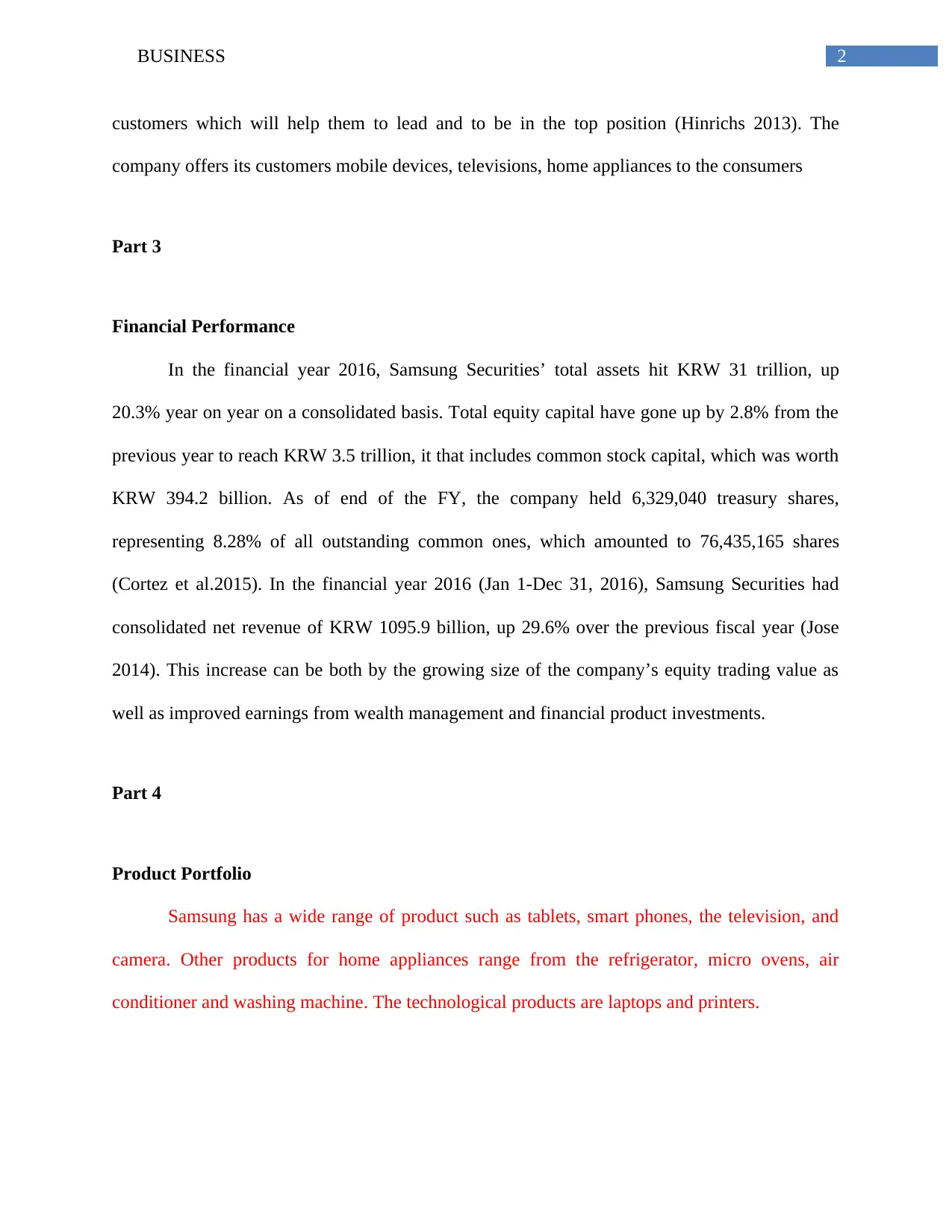
2BUSINESS
customers which will help them to lead and to be in the top position (Hinrichs 2013). The
company offers its customers mobile devices, televisions, home appliances to the consumers
Part 3
Financial Performance
In the financial year 2016, Samsung Securities’ total assets hit KRW 31 trillion, up
20.3% year on year on a consolidated basis. Total equity capital have gone up by 2.8% from the
previous year to reach KRW 3.5 trillion, it that includes common stock capital, which was worth
KRW 394.2 billion. As of end of the FY, the company held 6,329,040 treasury shares,
representing 8.28% of all outstanding common ones, which amounted to 76,435,165 shares
(Cortez et al.2015). In the financial year 2016 (Jan 1-Dec 31, 2016), Samsung Securities had
consolidated net revenue of KRW 1095.9 billion, up 29.6% over the previous fiscal year (Jose
2014). This increase can be both by the growing size of the company’s equity trading value as
well as improved earnings from wealth management and financial product investments.
Part 4
Product Portfolio
Samsung has a wide range of product such as tablets, smart phones, the television, and
camera. Other products for home appliances range from the refrigerator, micro ovens, air
conditioner and washing machine. The technological products are laptops and printers.
customers which will help them to lead and to be in the top position (Hinrichs 2013). The
company offers its customers mobile devices, televisions, home appliances to the consumers
Part 3
Financial Performance
In the financial year 2016, Samsung Securities’ total assets hit KRW 31 trillion, up
20.3% year on year on a consolidated basis. Total equity capital have gone up by 2.8% from the
previous year to reach KRW 3.5 trillion, it that includes common stock capital, which was worth
KRW 394.2 billion. As of end of the FY, the company held 6,329,040 treasury shares,
representing 8.28% of all outstanding common ones, which amounted to 76,435,165 shares
(Cortez et al.2015). In the financial year 2016 (Jan 1-Dec 31, 2016), Samsung Securities had
consolidated net revenue of KRW 1095.9 billion, up 29.6% over the previous fiscal year (Jose
2014). This increase can be both by the growing size of the company’s equity trading value as
well as improved earnings from wealth management and financial product investments.
Part 4
Product Portfolio
Samsung has a wide range of product such as tablets, smart phones, the television, and
camera. Other products for home appliances range from the refrigerator, micro ovens, air
conditioner and washing machine. The technological products are laptops and printers.
⊘ This is a preview!⊘
Do you want full access?
Subscribe today to unlock all pages.

Trusted by 1+ million students worldwide
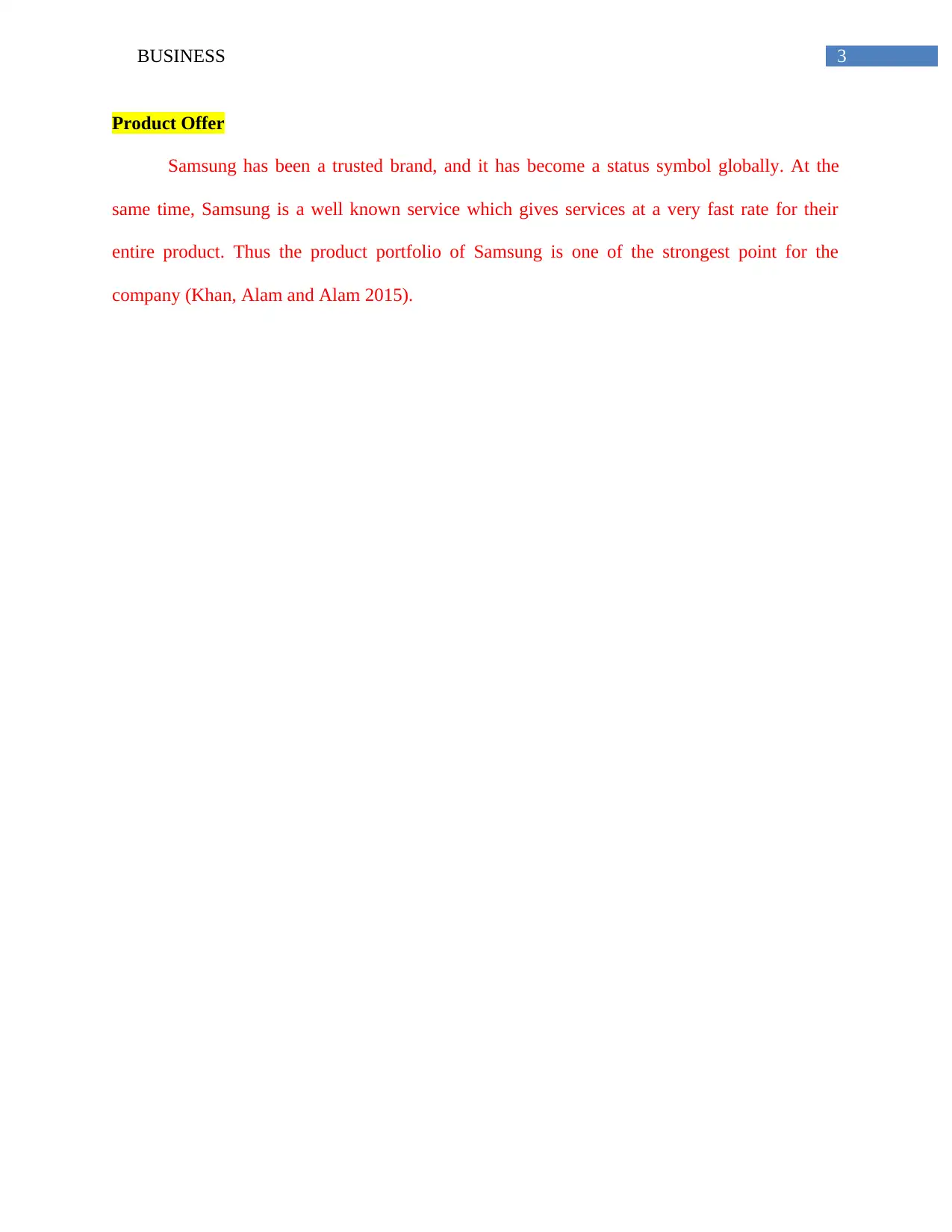
3BUSINESS
Product Offer
Samsung has been a trusted brand, and it has become a status symbol globally. At the
same time, Samsung is a well known service which gives services at a very fast rate for their
entire product. Thus the product portfolio of Samsung is one of the strongest point for the
company (Khan, Alam and Alam 2015).
Product Offer
Samsung has been a trusted brand, and it has become a status symbol globally. At the
same time, Samsung is a well known service which gives services at a very fast rate for their
entire product. Thus the product portfolio of Samsung is one of the strongest point for the
company (Khan, Alam and Alam 2015).
Paraphrase This Document
Need a fresh take? Get an instant paraphrase of this document with our AI Paraphraser

4BUSINESS
Answer to Question 2
Part 1
Evaluation of Samsung using SWOT and PESTLE
SWOT Analysis
INTERNAL FACTORS EXTERNAL FACTORS
Positive
Factors
Strengths Opportunities
Samsung is best at manufacturing and selling
electronics products (Ji et al.2015).
Due to the recent development in technology
and the minds of the people there is a demand
for smart phones (Salah 2015).
They own their own research and
development team and has their own
intellectual property and patent right of their
products (Hartley, 2017).
The competitors do not have a well
established research and development team
but Samsung has already established their
R&D team (Lichthart et al. 2017).
The employee have the skill and knowledge
about the latest technology (Sheppard 2016)
The new technology such as aneroid features
in smart phones and tablets are in demand in
the market (Dermawan 2014).
They have huge financial resources (Scott
2017).
The company can capture the market of Asia
and some portion of Europe (Ramiz et
al.2014).
Negative Weakness Threats
Answer to Question 2
Part 1
Evaluation of Samsung using SWOT and PESTLE
SWOT Analysis
INTERNAL FACTORS EXTERNAL FACTORS
Positive
Factors
Strengths Opportunities
Samsung is best at manufacturing and selling
electronics products (Ji et al.2015).
Due to the recent development in technology
and the minds of the people there is a demand
for smart phones (Salah 2015).
They own their own research and
development team and has their own
intellectual property and patent right of their
products (Hartley, 2017).
The competitors do not have a well
established research and development team
but Samsung has already established their
R&D team (Lichthart et al. 2017).
The employee have the skill and knowledge
about the latest technology (Sheppard 2016)
The new technology such as aneroid features
in smart phones and tablets are in demand in
the market (Dermawan 2014).
They have huge financial resources (Scott
2017).
The company can capture the market of Asia
and some portion of Europe (Ramiz et
al.2014).
Negative Weakness Threats
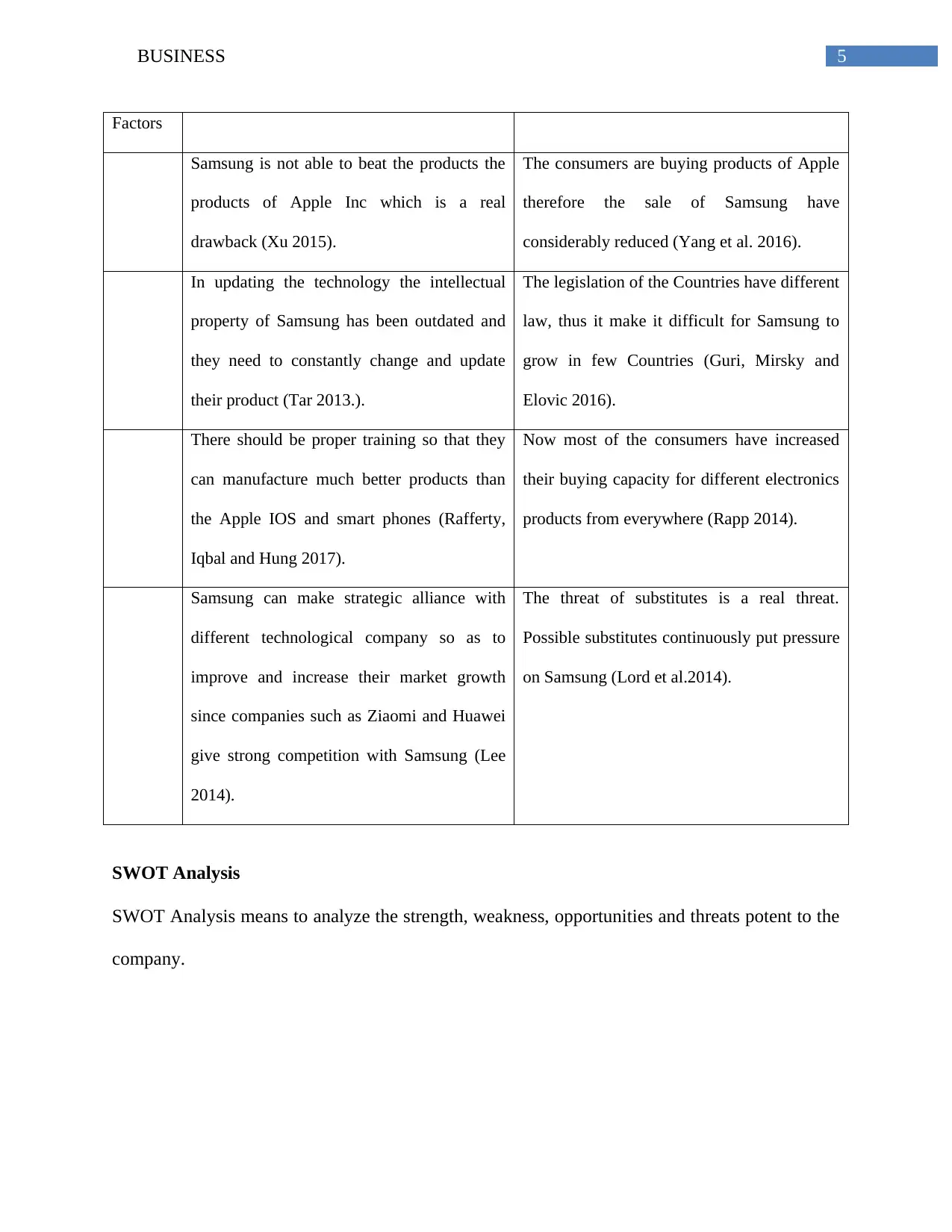
5BUSINESS
Factors
Samsung is not able to beat the products the
products of Apple Inc which is a real
drawback (Xu 2015).
The consumers are buying products of Apple
therefore the sale of Samsung have
considerably reduced (Yang et al. 2016).
In updating the technology the intellectual
property of Samsung has been outdated and
they need to constantly change and update
their product (Tar 2013.).
The legislation of the Countries have different
law, thus it make it difficult for Samsung to
grow in few Countries (Guri, Mirsky and
Elovic 2016).
There should be proper training so that they
can manufacture much better products than
the Apple IOS and smart phones (Rafferty,
Iqbal and Hung 2017).
Now most of the consumers have increased
their buying capacity for different electronics
products from everywhere (Rapp 2014).
Samsung can make strategic alliance with
different technological company so as to
improve and increase their market growth
since companies such as Ziaomi and Huawei
give strong competition with Samsung (Lee
2014).
The threat of substitutes is a real threat.
Possible substitutes continuously put pressure
on Samsung (Lord et al.2014).
SWOT Analysis
SWOT Analysis means to analyze the strength, weakness, opportunities and threats potent to the
company.
Factors
Samsung is not able to beat the products the
products of Apple Inc which is a real
drawback (Xu 2015).
The consumers are buying products of Apple
therefore the sale of Samsung have
considerably reduced (Yang et al. 2016).
In updating the technology the intellectual
property of Samsung has been outdated and
they need to constantly change and update
their product (Tar 2013.).
The legislation of the Countries have different
law, thus it make it difficult for Samsung to
grow in few Countries (Guri, Mirsky and
Elovic 2016).
There should be proper training so that they
can manufacture much better products than
the Apple IOS and smart phones (Rafferty,
Iqbal and Hung 2017).
Now most of the consumers have increased
their buying capacity for different electronics
products from everywhere (Rapp 2014).
Samsung can make strategic alliance with
different technological company so as to
improve and increase their market growth
since companies such as Ziaomi and Huawei
give strong competition with Samsung (Lee
2014).
The threat of substitutes is a real threat.
Possible substitutes continuously put pressure
on Samsung (Lord et al.2014).
SWOT Analysis
SWOT Analysis means to analyze the strength, weakness, opportunities and threats potent to the
company.
⊘ This is a preview!⊘
Do you want full access?
Subscribe today to unlock all pages.

Trusted by 1+ million students worldwide
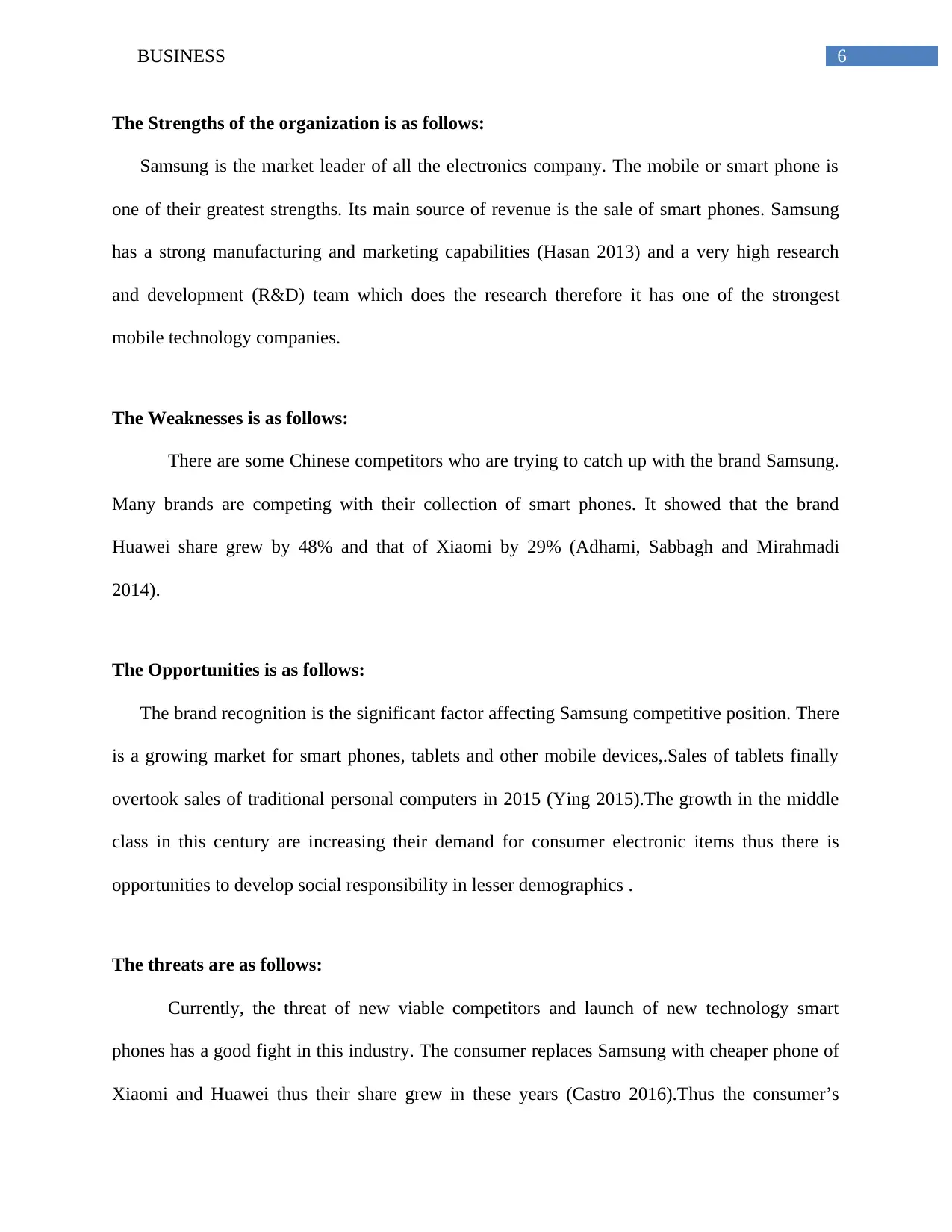
6BUSINESS
The Strengths of the organization is as follows:
Samsung is the market leader of all the electronics company. The mobile or smart phone is
one of their greatest strengths. Its main source of revenue is the sale of smart phones. Samsung
has a strong manufacturing and marketing capabilities (Hasan 2013) and a very high research
and development (R&D) team which does the research therefore it has one of the strongest
mobile technology companies.
The Weaknesses is as follows:
There are some Chinese competitors who are trying to catch up with the brand Samsung.
Many brands are competing with their collection of smart phones. It showed that the brand
Huawei share grew by 48% and that of Xiaomi by 29% (Adhami, Sabbagh and Mirahmadi
2014).
The Opportunities is as follows:
The brand recognition is the significant factor affecting Samsung competitive position. There
is a growing market for smart phones, tablets and other mobile devices,.Sales of tablets finally
overtook sales of traditional personal computers in 2015 (Ying 2015).The growth in the middle
class in this century are increasing their demand for consumer electronic items thus there is
opportunities to develop social responsibility in lesser demographics .
The threats are as follows:
Currently, the threat of new viable competitors and launch of new technology smart
phones has a good fight in this industry. The consumer replaces Samsung with cheaper phone of
Xiaomi and Huawei thus their share grew in these years (Castro 2016).Thus the consumer’s
The Strengths of the organization is as follows:
Samsung is the market leader of all the electronics company. The mobile or smart phone is
one of their greatest strengths. Its main source of revenue is the sale of smart phones. Samsung
has a strong manufacturing and marketing capabilities (Hasan 2013) and a very high research
and development (R&D) team which does the research therefore it has one of the strongest
mobile technology companies.
The Weaknesses is as follows:
There are some Chinese competitors who are trying to catch up with the brand Samsung.
Many brands are competing with their collection of smart phones. It showed that the brand
Huawei share grew by 48% and that of Xiaomi by 29% (Adhami, Sabbagh and Mirahmadi
2014).
The Opportunities is as follows:
The brand recognition is the significant factor affecting Samsung competitive position. There
is a growing market for smart phones, tablets and other mobile devices,.Sales of tablets finally
overtook sales of traditional personal computers in 2015 (Ying 2015).The growth in the middle
class in this century are increasing their demand for consumer electronic items thus there is
opportunities to develop social responsibility in lesser demographics .
The threats are as follows:
Currently, the threat of new viable competitors and launch of new technology smart
phones has a good fight in this industry. The consumer replaces Samsung with cheaper phone of
Xiaomi and Huawei thus their share grew in these years (Castro 2016).Thus the consumer’s
Paraphrase This Document
Need a fresh take? Get an instant paraphrase of this document with our AI Paraphraser

7BUSINESS
buying power also represents a key threat in the industry. Consumers can easily switch to Apple
products since their product IOS is much recognized than the Samsung tablet. Thus Apple
entered the home appliance and consumer market too.
buying power also represents a key threat in the industry. Consumers can easily switch to Apple
products since their product IOS is much recognized than the Samsung tablet. Thus Apple
entered the home appliance and consumer market too.

8BUSINESS
Part 2
PESTLE Analysis
Part 2
PESTLE Analysis
⊘ This is a preview!⊘
Do you want full access?
Subscribe today to unlock all pages.

Trusted by 1+ million students worldwide
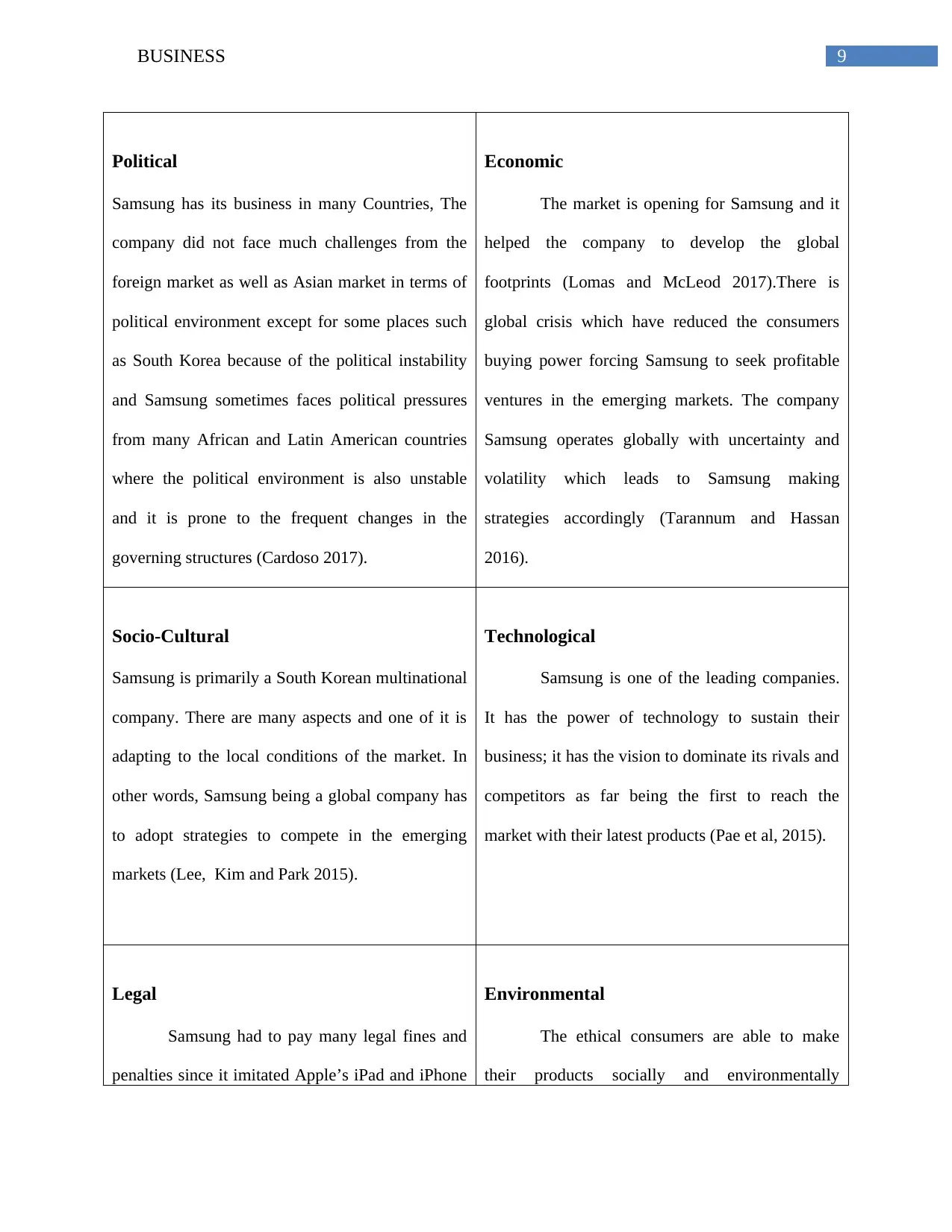
9BUSINESS
Political
Samsung has its business in many Countries, The
company did not face much challenges from the
foreign market as well as Asian market in terms of
political environment except for some places such
as South Korea because of the political instability
and Samsung sometimes faces political pressures
from many African and Latin American countries
where the political environment is also unstable
and it is prone to the frequent changes in the
governing structures (Cardoso 2017).
Economic
The market is opening for Samsung and it
helped the company to develop the global
footprints (Lomas and McLeod 2017).There is
global crisis which have reduced the consumers
buying power forcing Samsung to seek profitable
ventures in the emerging markets. The company
Samsung operates globally with uncertainty and
volatility which leads to Samsung making
strategies accordingly (Tarannum and Hassan
2016).
Socio-Cultural
Samsung is primarily a South Korean multinational
company. There are many aspects and one of it is
adapting to the local conditions of the market. In
other words, Samsung being a global company has
to adopt strategies to compete in the emerging
markets (Lee, Kim and Park 2015).
Technological
Samsung is one of the leading companies.
It has the power of technology to sustain their
business; it has the vision to dominate its rivals and
competitors as far being the first to reach the
market with their latest products (Pae et al, 2015).
Legal
Samsung had to pay many legal fines and
penalties since it imitated Apple’s iPad and iPhone
Environmental
The ethical consumers are able to make
their products socially and environmentally
Political
Samsung has its business in many Countries, The
company did not face much challenges from the
foreign market as well as Asian market in terms of
political environment except for some places such
as South Korea because of the political instability
and Samsung sometimes faces political pressures
from many African and Latin American countries
where the political environment is also unstable
and it is prone to the frequent changes in the
governing structures (Cardoso 2017).
Economic
The market is opening for Samsung and it
helped the company to develop the global
footprints (Lomas and McLeod 2017).There is
global crisis which have reduced the consumers
buying power forcing Samsung to seek profitable
ventures in the emerging markets. The company
Samsung operates globally with uncertainty and
volatility which leads to Samsung making
strategies accordingly (Tarannum and Hassan
2016).
Socio-Cultural
Samsung is primarily a South Korean multinational
company. There are many aspects and one of it is
adapting to the local conditions of the market. In
other words, Samsung being a global company has
to adopt strategies to compete in the emerging
markets (Lee, Kim and Park 2015).
Technological
Samsung is one of the leading companies.
It has the power of technology to sustain their
business; it has the vision to dominate its rivals and
competitors as far being the first to reach the
market with their latest products (Pae et al, 2015).
Legal
Samsung had to pay many legal fines and
penalties since it imitated Apple’s iPad and iPhone
Environmental
The ethical consumers are able to make
their products socially and environmentally
Paraphrase This Document
Need a fresh take? Get an instant paraphrase of this document with our AI Paraphraser
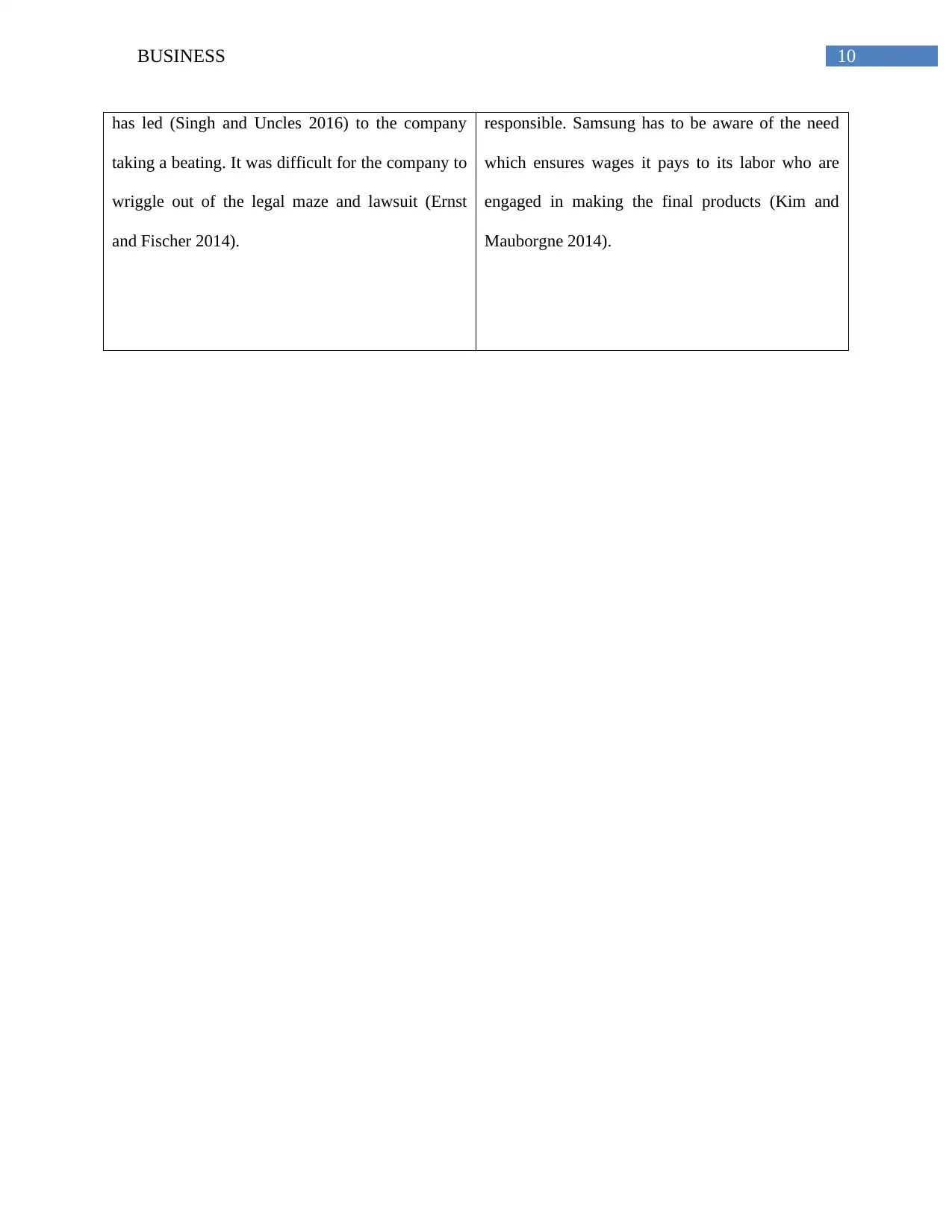
10BUSINESS
has led (Singh and Uncles 2016) to the company
taking a beating. It was difficult for the company to
wriggle out of the legal maze and lawsuit (Ernst
and Fischer 2014).
responsible. Samsung has to be aware of the need
which ensures wages it pays to its labor who are
engaged in making the final products (Kim and
Mauborgne 2014).
has led (Singh and Uncles 2016) to the company
taking a beating. It was difficult for the company to
wriggle out of the legal maze and lawsuit (Ernst
and Fischer 2014).
responsible. Samsung has to be aware of the need
which ensures wages it pays to its labor who are
engaged in making the final products (Kim and
Mauborgne 2014).

11BUSINESS
Answer to Question 3
Market situation, market segment and market share of the company Samsung in the
industry
Part 1
Samsung Electronics is a global leader in semiconductors and digital media technologies
and it is renounced. They have the Headquarter in South Korea. Samsung has many people
worldwide and it spends around 10 billion U.S. dollars for their research and development every
year (Harutyunyan, Jiang and Narasimhan 2016).
Part 2
Market Share & Market Segment
There are many products that are manufactured by Samsung Electronics. Out of which
the most renowned product is the latest version mobile phone that Samsung Galaxy III. In this
segment Samsung enjoys maximum market share from their mobile phone. In this segment
Samsung holds 32.6 percent and with its competitors Apple having a market share of 49 percent.
In case of Xiaomi holds the maximum market share of 41.6 percent and its nearest competitor. In
case of demand for the product Samsung galaxy III is very high and it has one of the largest
market share having at the second position with 26.2 percent while Apple IOS has market share
of 30.4 percent (Giachetti and Torrisi 2017).
Answer to Question 3
Market situation, market segment and market share of the company Samsung in the
industry
Part 1
Samsung Electronics is a global leader in semiconductors and digital media technologies
and it is renounced. They have the Headquarter in South Korea. Samsung has many people
worldwide and it spends around 10 billion U.S. dollars for their research and development every
year (Harutyunyan, Jiang and Narasimhan 2016).
Part 2
Market Share & Market Segment
There are many products that are manufactured by Samsung Electronics. Out of which
the most renowned product is the latest version mobile phone that Samsung Galaxy III. In this
segment Samsung enjoys maximum market share from their mobile phone. In this segment
Samsung holds 32.6 percent and with its competitors Apple having a market share of 49 percent.
In case of Xiaomi holds the maximum market share of 41.6 percent and its nearest competitor. In
case of demand for the product Samsung galaxy III is very high and it has one of the largest
market share having at the second position with 26.2 percent while Apple IOS has market share
of 30.4 percent (Giachetti and Torrisi 2017).
⊘ This is a preview!⊘
Do you want full access?
Subscribe today to unlock all pages.

Trusted by 1+ million students worldwide
1 out of 27
Related Documents
Your All-in-One AI-Powered Toolkit for Academic Success.
+13062052269
info@desklib.com
Available 24*7 on WhatsApp / Email
![[object Object]](/_next/static/media/star-bottom.7253800d.svg)
Unlock your academic potential
Copyright © 2020–2025 A2Z Services. All Rights Reserved. Developed and managed by ZUCOL.





